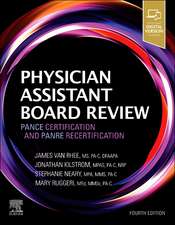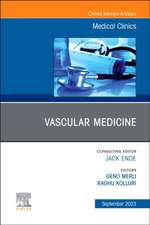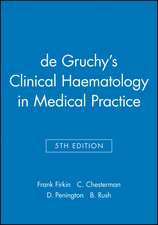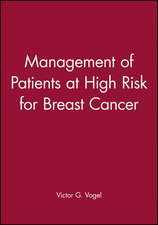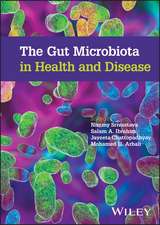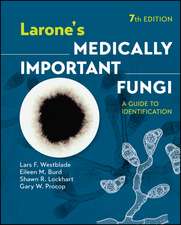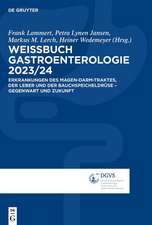Prevention in Clinical Practice
Autor D.H. Becker, L.B. Gardneren Limba Engleză Paperback – 29 mar 2012
Preț: 384.65 lei
Preț vechi: 404.89 lei
-5% Nou
Puncte Express: 577
Preț estimativ în valută:
73.61€ • 76.05$ • 61.26£
73.61€ • 76.05$ • 61.26£
Carte tipărită la comandă
Livrare economică 25 martie-08 aprilie
Preluare comenzi: 021 569.72.76
Specificații
ISBN-13: 9781468453584
ISBN-10: 1468453580
Pagini: 472
Ilustrații: 468 p.
Dimensiuni: 178 x 254 x 25 mm
Greutate: 0.81 kg
Ediția:Softcover reprint of the original 1st ed. 1988
Editura: Springer Us
Colecția Springer
Locul publicării:New York, NY, United States
ISBN-10: 1468453580
Pagini: 472
Ilustrații: 468 p.
Dimensiuni: 178 x 254 x 25 mm
Greutate: 0.81 kg
Ediția:Softcover reprint of the original 1st ed. 1988
Editura: Springer Us
Colecția Springer
Locul publicării:New York, NY, United States
Public țintă
ResearchCuprins
1. Patterns of Illness and Medical Practice in the United States.- 1. Introduction.- 2. Morbidity and Mortality in the United States.- 2.1. Adolescents and Young Adults.- 2.2. Adults.- 2.3. Elderly.- 3. Patterns of Practice.- 4. Prevention.- References.- 2. History of Preventive Medicine.- 1. Introduction.- 2. Personal Health.- 3. Society.- 4. Applied Science.- 5. United States.- References.- 3. Screening for Early Disease: Interpretation of Diagnostic Tests.- 1. Introduction.- 1.1. Diagnosis of Asymptomatic Disease.- 1.2. Identification of Risk Factors for the Development of Disease.- 1.3. Monitoring the Result of an Intervention Aiding in Disease Prevention.- 2. Terminology.- 2.1. Two-by-Two Table.- 2.2. Gold Standard.- 2.3. Sensitivity and Specificity.- 2.4. Accuracy of Positive Prediction and Accuracy of Negative Prediction.- 2.5. Prevalence.- 2.6. Reliability.- 3. Effect of Prevalence on Predictive Values.- 4. Characteristics of a Good Screening Test.- 4.1. High Sensitivity.- 4.2. Relatively High Specificity.- 4.3. Simplicity.- 4.4. Safety.- 4.5. Acceptability.- 4.6. Low Cost.- 5. Factors That Affect Sensitivity and Specificity.- 5.1. Spectrum of Patients.- 5.2. Bias.- 5.3. Exercise Testing as an Example.- 6. Characteristics of Diseases for which Screening Is Worthwhile.- 6.1. Relatively High Prevalence.- 6.2. Long Duration.- 6.3. Serious Consequences.- 6.4. Treatable Disease.- 7. Distortions Created by Screening.- 7.1. Pseudodisease.- 7.2. Bias.- 8. Application of Diagnostic Test Theory to Screening Tests.- 8.1. Syphilis Screening.- 8.2. Screening for Coronary Artery Disease.- 8.3. Screening for Breast Cancer.- References.- 4. Adult Immunization.- 1. Introduction.- 2. Influenza Vaccine.- 3. Pneumococcal Vaccine.- 4. Measles, Mumps, and Rubella Vaccines.- 5. Poliomyelitis Vaccines.- 6. Combined Tetanus and Diphtheria Toxoid.- 7. Conclusion.- References.- 5. Antimicrobial Prophylaxis.- 1. Introduction.- 2. Indications for Use.- 2.1. Exposure to a Specific Pathogen.- 2.2. Predisposition to Infection.- 2.3. Surgical Infections.- References.- 6. Hepatitis.- 1. Introduction.- 2. Hepatitis A.- 2.1. The Virus.- 2.2. Epidemiology.- 2.3. Mode of Transmission.- 2.4. Incidence.- 2.5. Incubation Period and Period of Communicability.- 2.6. Strategies for Prevention and Infection.- 2.7. Prevention of Viral Spread.- 2.8. Passive Immunoprophylaxis.- 3. Hepatitis B.- 3.1. The Virus.- 3.2. Spectrum of Disease.- 3.3. Epidemiology.- 3.4. Modes of Transmission.- 3.5. Incubation Period and Period of Communicability.- 3.6. Strategies for Prevention of Infection.- 4. Delta Agent.- 4.1. The Virus.- 4.2. Spectrum of Disease.- 4.3. Epidemiology.- 4.4. Modes of Transmission.- 4.5. Strategies for Prevention of Infection.- 5. Non-A-Non-B Hepatitis.- 5.1. The Virus.- 5.2. Spectrum of Disease.- 5.3. Epidemiology.- 5.4. Strategies for Prevention of Infection.- References.- 7. Streptococcal Pharyngitis.- 1. Introduction.- 2. Epidemiology.- 2.1. Streptococcal Pharyngitis.- 2.2. Rheumatic Fever.- 3. Rationale for Treatment.- 4. Diagnosis.- 4.1. Clinical Diagnosis of GABHS Pharyngitis.- 4.2. Throat Culture.- 4.3. Rapid Tests Utilizing Group A Streptococcal Antigen.- 4.4. Use of Tests in Clinical Situations.- 5. Prevention of Rheumatic Fever.- 6. Prevention of Recurrences of Rheumatic Fever.- 7. Treatment of Streptococcal Pharyngitis.- 8. Endocarditis Prophylaxis.- 9. Future Developments.- References.- 8. Tuberculosis.- 1. Introduction.- 2. Epidemiology.- 2.1. Risk of Infection.- 2.2. Risk of Active Disease.- 3. Preventive Strategies.- 3.1. Primary Prevention—BCGVaccination.- 3.2. Secondary Prevention.- 4. Active Tuberculosis.- 5. Special Situations.- 5.1. Urban Tuberculosis and the Homeless.- 5.2. Drug-Resistant Tuberculosis.- 5.3. Tuberculosis and Acquired Immunodeficiency Syndrome.- 6. Summary.- References.- 9. Sexually Transmitted Diseases.- 1. Introduction.- 2. Epidemiology.- 2.1. Incidence of STDs.- 2.2. Factors Influencing STD Trends.- 2.3. Magnitude of the STD Problem.- 3. Transmission of STD Agents.- 4. Prevention of STDs.- 4.1. Primary Prevention.- 4.2. Secondary Prevention.- 4.3. Tertiary Prevention—Rehabilitation.- 5. Prevention of STDs in Newborns.- 6. Prevention of STDs in Homosexuals.- References.- 10. AIDS.- 1. Introduction.- 2. Epidemiology.- 2.1. Risk Characteristics.- 2.2. Male Homosexuality.- 2.3. Intravenous Drug Use.- 2.4. Heterosexual Transmission.- 2.5. Nonsexual Contact.- 2.6. Health Care Workers.- 2.7. Blood Transfusions and Blood Products.- 2.8. Vectors and Environmental Factors.- 3. Diagnosis of HIV Infection.- 3.1. Diagnostic Criteria and Classification.- 3.2. Diagnosis: Laboratory Methods.- 3.3. Clinical Evaluation.- 4. Counseling Patients.- 4.1. Prognosis.- 4.2. Precautions.- 4.3. Measures to Maintain Health.- 5. Counseling Patients at Risk for HIV Infection.- 6. Precautions for Health Care Workers.- References.- 11. Coronary Artery Disease.- 1. Introduction.- 2. Risk Factors for Coronary Artery Disease.- 2.1. Cigarette Smoking.- 2.2. Hypertension.- 2.3. Diabetes.- 2.4. Lipid Abnormalities.- 2.5. Obesity.- 2.6. Other Potentially Modifiable Risk Factors.- 3. Rationale for Prevention.- 4. Office Strategies.- 4.1. Primary Prevention.- 4.2. Secondary Prevention.- References.- 12. Diabetes.- 1. Introduction.- 2. Concepts Concerning Diabetes Prevention.- 3. Prevention of Acute Complications.- 3.1.Diabetic Ketoacidosis.- 3.2. Hyperosmolar Hyperglycemia Nonketotic Diabetic Coma.- 3.3. Hypoglycemia.- 4. Prevention of Chronic Complications.- 4.1. Introduction.- 4.2. Retinopathy.- 4.3. Nephropathy.- 4.4. Neuropathy.- 4.5. Foot Ulceration.- 4.6. Macrovascular Disease.- 5. Diabetes and Pregnancy.- 6. Conclusion.- References.- 13. Hypertension.- 1. Introduction.- 2. Measurement of Blood Pressure.- 3. Definitions of Hypertension.- 4. Epidemiology and Risk.- 5. Efficacy of Treatment.- 6. Nonpharmacological Treatment.- 7. Evaluation of Hypertension.- References.- 14. Thromboembolism.- 1. Epidemiology.- 1.1. Frequency.- 1.2. Morbidity.- 1.3. Risk Factors.- 2. Tests for Thromboembolism.- 2.1. Venous Thrombosis.- 2.2. Pulmonary Embolism.- 3. Prevention.- 3.1. Mechanical Methods.- 3.2. Pharmacological Methods.- 3.3. Combination Treatment.- 4. Costs, Risks, Benefits.- References.- 15. Nephrolithiasis.- 1. Introduction.- 1.1. Diagnosis.- 1.2. Metabolic Evaluation of the Patient with Nephrolithiasis.- 2. Predisposing Factors.- 2.1. Oxalate Stones.- 2.2. Magnesium Ammonium Phosphate (Struvite) and Calcium Phosphate (Apatite)—“Triple-Phosphate Stones”.- 2.3. Calcium Phosphate Stones.- 2.4. Uric Acid Nephrolithiasis.- 2.5. Cystine Stones.- 2.6. Summary.- 3. Prevention: General Principles and Specific Therapies.- 3.1. General Principles.- 3.2. Calcium Oxalate Nephrolithiasis.- 3.3. Prevention of Idiopathic Calcium Stones.- 3.4. Prevention of Triple-Phosphate Stones.- 3.5. Prevention of Calcium Phosphate Stones.- 3.6. Prevention of Uric Acid Nephrolithiasis.- 3.7. Prevention of Cystine Stones.- 3.8. Summary.- References.- 16. Cancer.- 1. Introduction.- 2. Carcinogenesis.- 3. Factors Associated with the Development of Cancer.- 4. Evidence for Cancer Prevention.- 4.1.International Differences in Cancer Incidence.- 4.2. Migration Studies.- 4.3. Laboratory Research.- 5. Adverse Factors in Cancer Causation.- 5.1. Smoking.- 5.2. Dietary Fat.- 6. Protective Factors.- 6.1. Vitamin A.- 6.2. Fiber.- 6.3. Other Protective Factors.- 7. Strategies for Cancer Prevention.- 7.1. Smoking Cessation.- 7.2. Dietary Changes.- 8. Early Detection of Cancer.- 8.1. Cancer of the Uterine Cervix.- 8.2. Breast Cancer.- 8.3. Lung Cancer.- 8.4. Colorectal Cancer.- 8.5. Prostatic Cancer.- 8.6. Malignant Melanoma.- 8.7. Endometrial Cancer.- 9. Exceptions.- 10. Economics.- References.- 17. Stroke.- 1. Stroke Epidemiology.- 1.1. Stroke Definition and Classification.- 1.2. Stroke Risk Factors.- 2. Asymptomatic Carotid Bruits.- 3. Transient Ischemic Attacks.- 4. Cardiac Disease and Stroke.- 4.1. Atrial Fibrillation.- 4.2. Mitral Valve Prolapse.- 4.3. Rheumatic Heart Disease.- 4.4. Myocardial Infarction.- 4.5. Prosthetic Heart Valves.- 4.6. Cardiomyopathy.- 5. Intracranial Hemorrhage.- 5.1. Congenital Berry Aneurysm.- 5.2. Arteriovenous Malformation.- 6. Conclusion.- References.- 18. Osteoporosis.- 1. Introduction.- 1.1. Definition.- 1.2. The Problem.- 1.3. Some New Ideas.- 2. Osteoporosis in Clinical Practice.- 2.1. Diagnosis.- 2.2. Classification.- 2.3. Risk Factors.- 2.4. Screening.- 3. Prevention.- 3.1. Calcium.- 3.2. Estrogens.- 3.3. Other Measures.- References.- 19. Preventable Visual Loss.- 1. Introduction.- 2. Glaucoma.- 2.1. Definitions.- 2.2. Epidemiology.- 2.3. Pathophysiology.- 2.4. Diagnosis and Screening.- 2.5. Corticosteroids and Glaucoma.- 2.6. Costs.- 3. Diabetic Retinopathy.- 4. Amblyopia.- 5. Injury Prevention.- References.- 20. Health Advice for International Travelers.- 1. Introduction.- 2. Epidemiology of Travel-Associated Illness.- 3. How to Find Health Information for Travelers.- 4. Pretrip Evaluation.- 5. Medical Aspects of Air Travel.- 6. Immunizations.- 6.1. Routine Vaccinations.- 6.2. Vaccines Sometimes Required.- 6.3. Vaccines Often Recommended for Tropical Travel.- 6.4. Vaccines for Special Circumstances.- 6.5. Discontinued or Unavailable Vaccines.- 7. Malaria Prophylaxis.- 8. Common-Sense Precautions while Traveling.- 8.1. Water.- 8.2. Food.- 8.3. Climate.- 8.4. Altitude.- 8.5. Traffic.- 8.6. Swimming.- 8.7. Insects.- 8.8. Animal Bites.- 8.9. Medications.- 9. Prevention and Treatment of Traveler’s Diarrhea.- 10. Assessing the Returning Traveler.- References.- 21. Occupational Medicine.- 1. Introduction.- 2. Guide to this Chapter.- 3. General Principles of Occupational Disease.- 4. Special Skills for the Practice of Occupational Medicine.- 4.1. Obtaining the Occupational History.- 4.2. Additional Sources of Exposure Information.- 4.3. Translating Exposure Data into Clinical Terms.- 4.4. Taking Action when Occupational Disease Is Suspected.- 4.5. Protecting the Patient.- 4.6. Protecting Present and Future Co-Workers.- 5. Principal Occupational Diseases Affecting the Major Organs.- 5.1. Lung Disease.- 5.2. Skin Disease.- 5.3. Cardiovascular Disease.- 5.4. Musculoskeletal Disorders.- 5.5. Gastrointestinal Disturbances.- 5.6. Neurological Disease.- 5.7. Psychiatric Illness.- 5.8. Disorders of the Urinary Tract.- 5.9. Endocrine/Reproductive Disorders.- 5.10. Infectious Diseases.- 5.11. Hematological Disorders.- 6. Conclusion.- Annotated Bibliography.- References.- 22. Nutrition.- 1. Introduction.- 2. Nutrition in the United States.- 2.1. Surveys.- 2.2. Nutritional Deficiency in Special Groups.- 3. Natural Food versus Processed Food.- 3.1. Organic Food.- 3.2. Pesticides and Additives.- 3.3. VegetarianDiets.- 3.4. Vitamin Misuse.- 3.5. Herbal Remedies.- 4. Obesity.- 4.1. Epidemiology.- 4.2. Associated Diseases.- 5. Lipids.- 5.1. Definitions.- 5.2. Lipids and Atherosclerosis.- 5.3. Determinants of Serum Cholesterol.- 5.4. Fish Oils.- 6. Sugar.- 6.1. Dietary Sugar.- 6.2. Sugar and Diabetes.- 6.3. Sugar and Dental Caries.- 6.4. Obesity.- 6.5. Fruits, Vegetables, Grains.- 7. Fiber.- 7.1. Definitions.- 7.2. Physiological Effects.- 7.3. Fiber and Disease.- 8. Salt.- 8.1. Physiology.- 8.2. Diet and Sodium.- 8.3. Sodium Requirements.- 8.4. Sodium and Hypertension.- 9. Vitamins and Trace Minerals.- 9.1. Vitamins.- 9.2. Minerals, Elements, Electrolytes.- 10. Dietary Change.- 10.1. Obesity and Weight Loss.- 10.2. Hypertension and Salt Restriction.- 10.3. Vascular Disease and Lipid Restriction.- 11. Summary.- References.- 23. Smoking.- 1. Prevalence.- 2. Lung Cancer.- 3. Pathological Changes.- 4. Coronary Heart Disease.- 5. Cerebrovascular Disease.- 6. Laryngeal Cancer.- 7. Oral Cancer.- 8. Esophageal Cancer.- 9. Bladder Cancer.- 10. Other Cancers.- 11. Chronic Lung Diseases.- 12. The Economics of Smoking.- 13. Smoking Cessation.- 14. Community Response to Smoking.- 15. Passive Smoking.- References.- 24. Mental Disorders.- 1. Introduction.- 2. Prevention of Mental Disorders.- 3. Epidemiology of Mental Disorders.- 4. Identifying the Groups at Risk for Mental Disorders.- 4.1. Life Stress.- 4.2. Family History.- 4.3. Acute and Chronic Medical Illness.- 5. Disorders Associated with Depression.- 6. Disorders Associated with Anxiety.- References.- 25. Alcoholism and Drug Abuse.- 1. Epidemiology.- 1.1. Alcoholism.- 1.2. Drug Abuse.- 2. Associated Psychiatric Illness.- 3. Associated Medical Illness.- 4. Social Costs.- 4.1. Economic Implications.- 4.2. Associated Violence.- 5. Recognition of Alcoholism.- 6. Rationale for Prevention.- 7. Substance Abuse Intervention: Detoxification and Rehabilitation.- 8. Summary.- References.- 26. Periodic Health Examination.- 1. Introduction.- 2. Definition of Terms.- 3. Selection of Preventable Conditions.- 4. Limitations of Periodic Health Examination.- 5. Clinical Implications of Periodic Health Examination.- 6. Historical Development of Periodic Health Examination.- 7. Recommendations for Periodic Health Examination.- 7.1. Recommendations of the 1970s.- 7.2. Recommendations of the 1980s.- 7.3. Specific Recommendations.- 7.4. Preventive Counseling.- 7.5. Immunization.- References.
Descriere
Prevention of disease and injury, including early identification of risks and disease and optimal control of potentially debilitating or fatal complications of chronic conditions, is the area of clinical medicine that holds the greatest promise for improving human health.


